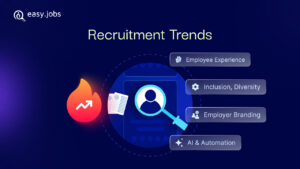If you are tired of all traditional recruiting solutions and are looking for the trendiest alternative, then you should go for social recruiting. Social media platforms play a significant role in catching up with the new generation in the ta, Gen Z and millennials. From recent data, we can see that people of these generations spend 3 to 4 hours per day on average on social media. So why not take advantage of it and find your next candidate through social recruiting?
Today, we will learn what social recruiting is, what the benefit of utilizing it is and most importantly, how to take the most benefit out of it. Let us get started.
![[2025 Guide] Social Recruiting: Stop Wasting Time, Start Finding Talent 1 Social recruiting](https://easy.jobs/wp-content/uploads/2024/09/EJ-Guide-Social-Recruiting_-Stop-Wasting-Time-Start-Finding-Talent-1024x576.jpg)
What is Social Recruiting?
Social media recruiting, aka social recruitin, is the practice of using social media platforms such as LinkedIn, Facebook, Twitter, Instagram and others to find, attract and engage potential job candidates. This strategy leverages the broad reach and networking capabilities of social media to build employer brand visibility, share job openings and directly communicate with both active and passive job seekers.
Using social recruiting, you are making a pitch to candidates where they spend most of their time. Using their preferred apps, you are pursuing applicants rather than just posting an advertisement and waiting for people to find you.
Key elements of social media recruiting include:
- Employer Branding: Sharing content that reflects the company’s culture, values and work environment to attract potential employees.
- Job Postings: Advertising vacant positions via targeted adverts or posts on company profiles and job-related communities.
- Networking: Joining relevant groups, participating in industry debates, and building relationships with possible candidates are all ways to engage them.
- Candidate Search: Actively seeking eligible applicants on social media channels, sometimes through hashtags, industry-specific networks, or referrals.
It is particularly useful for finding passive candidates who might not be actively looking for jobs but could be interested in the right opportunity when presented.
Social Media Recruiting Statistics to Measure Hiring Effectiveness
Should you start social recruiting? What is the success rate or social influence of it? Is there a measurement to show the effectiveness of social media for hiring?
To help you understand all these factors better, we have gathered data and statistics about social recruiting. Let’s have a glance.
1. 79% of job seekers use social media platforms in their job search.
If you play your cards well, more job seekers will apply for a position at your company than your competitors.
2. 84% of businesses are using social media for recruitment and 9% are planning to use it.
An SHRM survey indicates that social recruiting is becoming more popular due to its effectiveness. Several companies use it to identify talent, broaden their talent pool and focus on candidates that they were previously unable to reach with conventional recruitment techniques.
3. 70% of hiring managers say they have successfully found and hired candidates through social media posts and ADs.
A BetterTeam survey indicates that social media recruiting is effective, with 70% of recruiting managers reporting that they have successfully hired candidates through social media.
4. 40 million people look for jobs on LinkedIn every week.
Among all social media recruitment platforms, LinkedIn is the most popular. If you can reach even 10% of these candidates, you can easily find high-quality candidates you are looking to fill.
5. 79% of job seekers use social media for company research.
Job seekers also use social media to vet applicants in addition to recruiters, who use it to investigate and evaluate prospects.
Top 3 Social Media Recruiting Tools for HRs
Companies are now more aligned in developing a targeted social media strategy that includes adopting the proper platform and staying up to speed on best practices and trends. Social media recruiting tools are the next-generation trend that has altered how we engage and communicate, bringing the world closer together and providing businesses with unparalleled access to a global talent pool. Check out the top social media recruiting tools from the world’s largest professional network to locate the talent you need to meet your hiring objectives.
![[2025 Guide] Social Recruiting: Stop Wasting Time, Start Finding Talent 2 Social recruiting](https://easy.jobs/wp-content/uploads/2024/09/image-5-1024x1024.jpeg)
Courtesy: TestGorilla
1. LinkedIn
Today, 98% of hiring teams leverage LinkedIn for posting job listings and sourcing candidates, making it one of the most trusted platforms for social recruiting. It connects you with business leaders, industry experts and your professional network, offering valuable insights into the global workforce, business trends and career opportunities.
As a globally popular social media platform, LinkedIn plays a crucial role in social recruiting strategies, helping you identify top talent actively seeking new job opportunities. You can precisely target the right candidates for various roles, whether you need part-time, full-time, project-based, or remote employees, based on your specific hiring needs.
2. Facebook
From sharing photos to providing valuable information, Facebook is another powerful tool for social recruiting and promoting your brand. Many recruiters actively use Facebook to post job openings and involve current employees in the hiring process. Additionally, its paid advertising options allow you to reach potential candidates by featuring job listings in their search results while they scroll through the platform. This makes Facebook an effective resource for sourcing top talent and building engagement around new opportunities.
3. X
Social recruiting on X is gaining traction among savvy recruiters who can make the most of the platform’s concise format. Despite its character limit, X allows you to upload photographs, videos, GIFs, and job listings with trendy keywords and hashtags like #hiringalert, #immediatejoiners, #freshers, or #remotejobs to increase visibility.
To simplify the application process, include hiring alerts with links to your career website or specific job postings in your company’s bio, allowing candidates to apply immediately. Additionally, recruiters can run reach campaigns to promote tweets, boosting visibility and connecting with potential applicants more effectively.
5+ Best Practices for Leveraging Social Recruiting Strategies to Acquire Talent
Now that you know why social media recruiting is beneficial for finding the best talent, here are a few tips and ideas you could put into practice. You should apply these best social recruiting practices to get the maximum outcome.
1. Utilize Talent Assessments & Build an Ideal Candidate Profile
Before taking action, you have to understand first what you want to achieve from the recent recruiting campaigns. That will help you to choose the right strategy, it can be social recruiting or any one of the traditional ways. Ideal candidate profiles (ICP) build clear expectations for what you need from applicants should they join you.
If you are facing challenges with poor hires, refining your ICP can improve your social recruiting strategy. Use your social recruiting posts to communicate that you are prioritizing specific skills over experience. This approach allows you to assess an applicant’s communication skills, attention to detail, motivation, and proficiency in key technical abilities, ensuring that you attract candidates who truly meet your needs.
2. Pick a Suitable Social Recruitment Channel
Different social media platforms cater to specific audiences and fulfill different functions in social recruiting. LinkedIn, for example, is appropriate for professional professions, whilst Instagram is most suited to artistic and creative positions. However, these platforms are not limited to specific industries.
To identify the best channels for your social recruiting efforts, study your competitors’ techniques and match your platform choices to your branding and outreach objectives. If your business is more B2C, platforms like Facebook, Instagram, or Threads with friendly, open interfaces are wonderful possibilities. If resources allow, consider using multiple platforms to reach a larger audience—just make sure each one receives the attention it requires for effective engagement.
Also, check out the earlier section where we have mentioned which are the most popular social recruiting tools and what outcome you may expect from them.
3. Embed Social Media Campaigns to Recruitment Marketing
Social recruiting is about ensuring potential candidates know you’re hiring and why your company is worth applying to. Once you have selected the ideal social media platforms, encourage prospects to engage and learn more about your job openings. With a strong employer brand and a well-defined ICP, a simple social media campaign can continuously engage qualified candidates while your post remains visible on their screens. Always prioritize social media in your recruitment marketing strategy, as these platforms are commonly used during people’s leisure time, not just for professional purposes.
4. Build a Stronger Employer Brand in Social Media
The distinction between employer branding and company branding lies in how you treat your employees. Employer branding highlights to job seekers what they can expect once they join your team.
In social recruiting, social media platforms provide the perfect opportunity to share internal case studies and insights into your workplace culture. By consistently sharing employer branding content through social media, you help potential candidates understand your work environment and values. Without these insights, there is a risk of attracting candidates with unrealistic expectations about your brand and company culture.
5. Create Strategy to Engage Passive Candidates
While posting jobs targets active job seekers, the key to effective social recruiting lies in building your brand with passive candidates in mind. Regularly share social media content that highlights your company culture and leadership, making your brand familiar to potential candidates.
By consistently posting engaging content and showcasing what it is like to work at your company, you embed your brand into people’s long-term memory. This approach not only attracts active job hunters but also creates a self-sustaining talent pipeline by nurturing passive prospects. Though it is a gradual process, this method saves time, money and effort in future hiring campaigns, as passive candidates will feel more confident and ready to join after seeing your brand consistently over time.
6. Monitor and Measure Recruiting Metrics
Running a data-driven recruitment is all about using numbers to measure how effective campaigns are on paper. But while you are going for a social recruiting strategy, you can not measure performance directly. So to measure success rate with social recruiting, you have to go in a different way.
For instance, you can monitor and measure performance marketing outcomes. This way you can see how successful your social recruiting was, how much impression it has created and so on. Another way to measure is using UTM URLs. This way, you can easily keep track of where your candidates are mostly coming from. Through social media recruiting, look carefully at how people engage with your posts.
These tested and proven practices will help you reach your target audience and succeed in your social recruiting efforts.
Bonus: 10+ Templates for Sharing Job Posts in Social Media
As we have already explored, the first and foremost step of successful social recruiting is to share the job posting. While you are sharing job postings on social media platforms, you need to make them interesting and grab the instant attention of potential candidates. Here are some templates you can use:
- Job Sharing Caption Template 1
You can use this one on any social media platform or for any position. This is the classic one.
‘We Are Hiring!’ 📣
We, [X] are looking for an experienced [Position Name] to join our company. In this role, your duties will include completing your assigned duties, leading your team and most importantly collaborating with other teams.
Apply here: {apply_link}
#joinus #jobopening #hiring
- Job Sharing Caption Template 2
You may easily advertise the number of positions available at your companies through the social media shares you make in order to attract potential candidates. Here is a sample copy you can use to promote vacancies.
Looking for 2 highly talented [Position Name] in our team!
To join as a [Position Name] in [X] company, you should have strong knowledge and the ability to work with a large amount of complex data. Ultimately, a top-notch [Position Name] should be a highly detailed and organized individual with an analytical power. If you feel you are suitable, then apply now!
Apply here: {apply_link}
#joinus #jobopening #hiring
Do you want to check out these kinds of stunning social media captions for job sharing? Then check out the blog mentioned below.
![10+ Social Media Captions To Share About Job Posts & Get More Applications [Templates] 1 Social recruiting](https://easy.jobs/wp-content/uploads/2024/09/image-4.jpeg)
10+ Social Media Captions To Share Job Posts & Get More Applications
Refill Your Talent Pool Consistently with Social Recruiting
Social media’s role in online marketing provides global reach, giving you countless opportunities to showcase your company to potential candidates. Social recruiting focuses on establishing employer branding for both active job seekers and passive future talent, ensuring your company stays top-of-mind.
Hopefully, this article will help you run a successful social recruiting campaign and help to find the best talent swiftly. To read these insightful recruiting tips, tricks, and trends, subscribe to our blog now. Happy recruiting!







